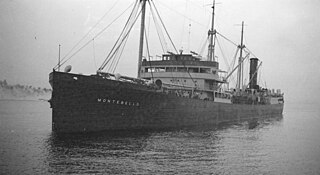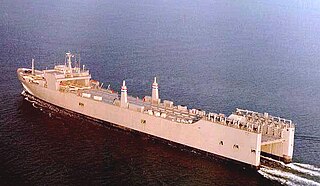Related Research Articles

APL, formerly called American President Lines Ltd., is a Singapore-based container shipping company that is a subsidiary of French shipping company CMA CGM. It operates an all-container ship fleet, including 153 container vessels.

Union Iron Works, located in San Francisco, California, on the southeast waterfront, was a central business within the large industrial zone of Potrero Point, for four decades at the end of the nineteenth and beginning of the twentieth centuries.
Concrete ships are built of steel and ferrocement instead of more traditional materials, such as steel or wood. The advantage of ferrocement construction is that materials are cheap and readily available, while the disadvantages are that construction labor costs are high, as are operating costs. During the late 19th century, there were concrete river barges in Europe, and during both World War I and World War II, steel shortages led the US military to order the construction of small fleets of ocean-going concrete ships, the largest of which was the SS Selma. United States Maritime Administration (MARAD) designation for concrete ships-barges was Type B ship. Few concrete ships were completed in time to see wartime service during World War I, but during 1944 and 1945, concrete ships and barges were used to support U.S. and British invasions in Europe and the Pacific. Since the late 1930s, there have also been ferrocement pleasure boats.

Hammac was a steam tank ship built in 1920–1921 by Bethlehem Shipbuilding Corporation of Alameda for the United States Shipping Board as part of the wartime shipbuilding program of the Emergency Fleet Corporation (EFC) to restore the nation's Merchant Marine. Early in 1923 the vessel together with two other tankers was sold to General Petroleum Corporation and renamed Emidio. The tanker spent the vast majority of her career carrying oil along the West Coast of the United States as well as between West and East coast. In December 1941 she was shelled and damaged by the Japanese submarine I-17 and eventually wrecked with a loss of five crew.
USS Triana (IX-223), an unclassified miscellaneous vessel, was the second ship of the United States Navy to be named for Rodrigo de Triana, the discoverer of the Americas.
The Western Pipe and Steel Company (WPS) was an American manufacturing company that is best remembered today for its construction of ships for the Maritime Commission in World War II. It also built ships for the U.S. Shipping Board in World War I and took part in the construction of the giant Grand Coulee Dam project in the 1930s.

SS Point Bonita was constructed in 1918 and launched 27 March 1918 after a hull being built for foreign owners at Albina Engine and Machine Works was requisitioned during World War I by the United States Shipping Board (USSB). The ship saw service as the Navy transport USS Point Bonita, assigned Identification Number 3496, from 7 October 1918 to 7 April 1919, was returned to the USSB and saw civilian service with several commercial companies as San Pedro and Oliver Olson before again seeing service in World War II as USS Camanga (AG-42). After return to commercial service as Oliver Olson the ship was wrecked at the entrance to Bandon harbor in Oregon.

The SS Faith was the first concrete ship built in the United States. It was constructed by the San Francisco Shipbuilding Company in 1918 owned by William Leslie Comyn. It cost $750,000.

Montebello was a steam oil tanker built in 1920–1921 by the Southwestern Shipbuilding Co. of San Pedro for Union Oil Company with the intention of carrying oil and petroleum products along the West Coast of the United States and Canada as well as between the United States and Chile. In December 1941 the tanker was sunk on one of her regular trips by the Japanese submarine I-21.

The SS Monte Carlo was a concrete ship launched in 1921 as the oil tanker SS Old North State. She was later renamed McKittrick. In 1932 she became a gambling and prostitution ship operating in international waters off the coast of Long Beach, California, United States, and was relocated to Coronado, California in 1936. The Monte Carlo was grounded on Coronado Island on New Year's Day 1937 during a storm and her wreck remains on the beach.
Domingo Marcucci, was a Venezuelan born 49er, shipbuilder and shipowner in San Francisco, California. He owned or captained some of the many steamships, steamboats, ferries, and sailing ships he built at San Francisco and elsewhere on the Pacific coast.
The SS Clovis Victory was the thirty-second Victory ship built during World War II, in 156 days under the Emergency Shipbuilding program. She was launched by the California Shipbuilding Company on June 13, 1944 and completed on August 31, 1944. The ship's United States Maritime Commission designation was VC2- S- AP3, hull number 27, operated by Seas Shipping Company. SS Clovis Victory served in the Pacific Ocean. Victory ships were designed to replace the earlier Liberty ships. Liberty ships were designed to be used just for WW2. Victory ships were designed to last longer and serve the US Navy after the war. The Victory ship differed from a Liberty ship in that they were: faster, longer and wider, taller, had a thinner stack set farther toward the superstructure, and had a long raised forecastle. The sponsor of the Clovis Victory was the wife of the 200th Coast Artillery's Henry Max Miller of Clovis, New Mexico. Major Miller was lost in the sinking of the SS Shinyō Maru on September 7, 1944.

The SS Cody Victory was a Victory ship (VC2-S-AP3) built during World War II under the Emergency Shipbuilding program. The ship's keel was laid by the California Shipbuilding Company as hull number 69 on 26 October 1944 with launch on 12 December 1944. The ship was completed on 22 January 1945. On completion the ship, U.S. Official Number 247094, was delivered to the War Shipping Administration for operation by the Alcoa SS Company as agent.
The SS Lewis Emery Jr. was a World War II liberty ship built by the Alabama Drydock and Shipbuilding Company at their yard at Mobile, Alabama, and launched on 15 October 1943.

Type C8-class ships are a type of Heavy Lift Barge Carrier. Type C8 ships were the 8th type of ship designed by the United States Maritime Commission (MARCOM) in the late 1960s. As done with the Type C1 ships and Type C2 ships, MARCOM circulated preliminary plans for comment. The design presented was not specific to any service or trade route. Type C8 ships measuring 876 feet (267 m) from stem to stern, and designed to make 16.2 knots.

SS Cynthia Olson was a cargo ship originally built in Wisconsin in 1918 as the SS Coquina. Renamed in 1940, in August 1941 she was chartered by the US Army to transport supplies to Hawaii. While in passage between Tacoma, Washington and Honolulu on December 7, she was intercepted by the Japanese submarine I-26, which sank her with gunfire. Although the commander of the submarine ensured that all of the crew had escaped into boats, none of them was ever found. Cynthia Olson was the first United States Merchant Marine vessel to be sunk after the entry of the United States into World War II.

Craig Shipbuilding was a shipbuilding company in Long Beach, California. To support the World War I demand for ships Craig Shipbuilding shipyard switched over to military construction and built: US Navy Submarines and Cargo Ships. Craig Shipbuilding was started in 1906 by John F. Craig. John F. Craig had worked in Toledo, Ohio with his father, John Craig (1838-1934), and Blythe Craig, both shipbuilders, their first ship was built in 1864 at Craig Shipbuilding Toledo. John F. Craig opened his shipbuilding company in Port of Long Beach on the south side of Channel 3, the current location of Pier 41 in the inner harbor, becoming the port's first shipyard. In 1907 Craig Shipbuilding is given a contract to dredge a channel from the Pacific ocean to the inner harbor. In 1917 Craig sold the shipyard to the California Shipbuilding Company. But then opened a new shipyard next to the one he just sold and called it the Long Beach Shipbuilding Company. The Long Beach Shipbuilding Company built cargo ships in 1918, 1919, and 1920 for the United States Shipping Board.
Haleakala was a steam cargo ship built in 1919 by Long Beach Shipbuilding Company of Long Beach for the United States Shipping Board (USSB) as part of the wartime shipbuilding program of the Emergency Fleet Corporation (EFC) to restore the nation's Merchant Marine. The vessel was first employed in the Pacific trade before being briefly laid up. She was reactivated in 1922 and entered the South American trade connecting the ports of Argentina and Brazil with a variety of ports in the Northeastern United States. In September 1926 while on one of her regular trips, she disappeared without a trace, possibly foundering in the hurricane with the loss of all hands.
Pacific Far East Line also called PFEL was a passenger and cargo ship line founded in 1943, by Thomas E. Cuffe, in San Francisco, California. At the started by chartering foreign ships to run the lines in tramp trade. Later scheduled cargo services was added to the line. During World War II the South Atlantic steamship line was active with charter shipping with the Maritime Commission and War Shipping Administration. After World War II Pacific Far East Line purchased some of the low-cost surplus ships. All purchased ships had names ending with the word "Bear". Pacific Far East Line flag was blue with a golden bear and below the letters PFEL. During wartime, the South Atlantic steamship line operated Victory ships and Liberty shipss. Thomas E. Cuffe died in 1959. Pacific Far East Line operated some Lighter aboard ship. Pacific Far East Line adds called PFEL routes: "Routes of the Bear". Pacific Far East Line failed to upgrade to all the ships to container ships and modernize as other shipping lines did in the 1970s. With the Vietnam War over Pacific Far East Line went bankrupt and closed in 1978, all ships being sold or scrapped due to age.

Calmar Steamship Company was a proprietary subsidiary of the Bethlehem Steel founded in New York City in 1927. Bethlehem Steel Company founded Calmar Steamship Company and other steamship companies after finding general shipping companies could not meet the company's needs in a timely manner. At the time Bethlehem Steel Company was the second-largest steelmaker in the United States and the world, only behind U.S. Steel. Calmar Steamship Company shipped Bethlehem Steel Company products from the Atlantic coast to the Pacific coast. On the return trip, Calmar Steamship Company would bring lumber products from the Pacific coast to the Atlantic coast. Calmar Steamship Company closed in 1976, as United States steel manufacture declined in the 1960s.
References
- ↑ Thomas, David Sea Classics, Jun 2004
- ↑ Sacramento County Biographies William Emil Gerber
- ↑ New York Times Mar 15, 1918 BIG CONCRETE SHIP AFLOAT IN PACIFIC
- ↑ Times Monday March 18, 1918 U. S. War Activities The Turning-Point
- ↑ Guide to the California business records, 1918-1932
- ↑ FindLaw for Legal Professionals - Case Law, Federal and State Resources, Forms, and Code
- Durham Bill, Ships of Stone to Beat the U-boats Steamboat Bill (of Facts) 19 (1962)
- Willis, William L., History of Sacramento County, California, Historic Record Company, Los Angeles, CA. 1913
- Robert Force, A. N. Yiannopoulos, Martin Davies Admiralty and Maritime Law Abridged Edition 2006 Beard Books ISBN 1-58798-290-0